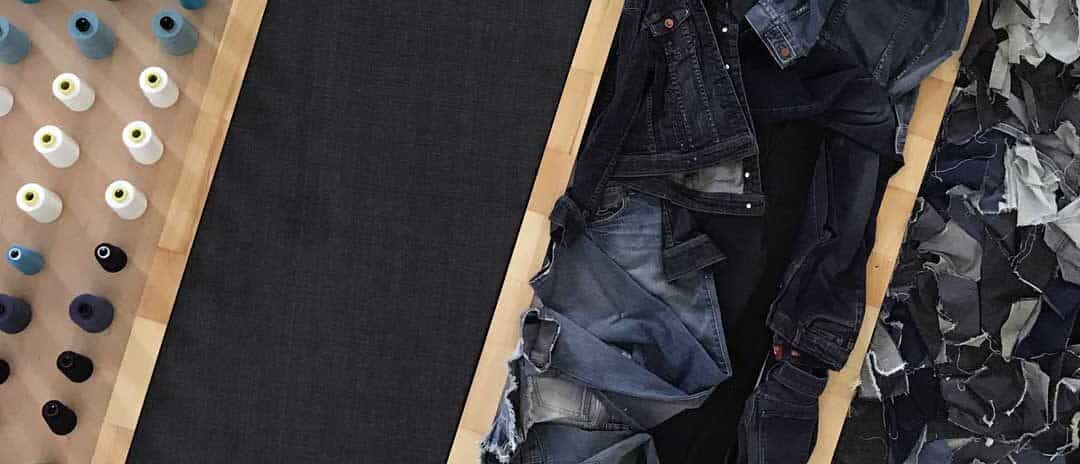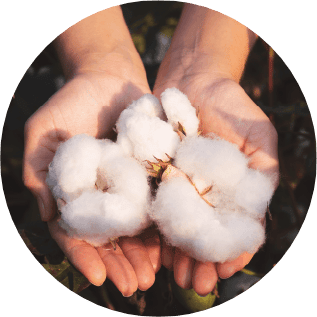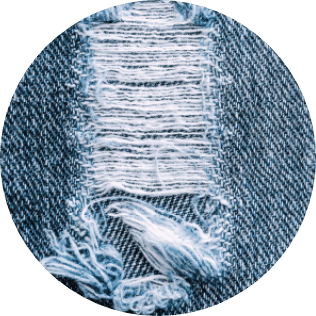
Microfibers in Water: Why Cotton is Better
All textiles shed tiny strands of material, called microfibers, during use and in the wash.

These microfibers are too small to be completely filtered by wastewater treatment equipment, so every time fabric is washed, microfibers enter our waterways. So, the type of fabric we choose matters, since synthetic textiles are responsible for 35% of the microplastics found in our oceans.1 If plastic pollution continues unchecked, there may be more plastic than fish in the oceans by 2050.2
Because they can’t be seen with the naked eye, microplastics can easily spread into different environments. In fact, on average, every one of us eats the equivalent of a credit card worth of microplastics every week without even knowing it.3 Reducing the amount of microplastics entering global ecosystems is critical, and we can all make a difference by changing how we choose to buy, use, reuse and dispose of a range of consumer goods – including textiles. Cotton microfibers are natural and biodegrade unlike synthetic fibers like polyester, and therefore cotton microfibers do not contribute to the plastic pollution problem.4

Research shows that cotton fabrics are compostable and degrade at much faster rates than polyester fabrics under industrial compost conditions.5

Cotton microfibers biodegrade by up to 90% in just 40 days in wastewater treatment environments.7

Even when treatments such as softeners, water repellents, and durable press are applied to cotton, the cotton still degrades to the same or a higher degree than oak leaves.6
IN THIS SECTION
Biocompatibility
Polyester and other synthetic fabrics are made using petrochemicals, which come from crude oil. In contrast, cotton is made from the natural fibers of cotton plants.
Biodegradation
Cotton microfibers biodegrade readily in wastewater treatment conditions, fresh water, and sea water whereas synthetic microfibers do not easily degrade and persist in the environment for long periods of time.8 In fact, recent research shows that cotton microfibers degrade faster than an oak leaf.9 After 35 days in lake water environments, 86% of cotton fibers had biodegraded,10 while it would take a polyester shirt between 20 and 200 years to completely decompose under the same conditions.11

Recent research has shown that when microfibers are shed from garments made of a cotton and polyester blend, the cotton microfibers biodegrade, while polyester does not. After as little as 20 days, much of the cotton microfibers are gone, leaving mostly polyester behind.12

Cotton Fiber Fragments & Water 2023
Cotton Incorporated Microfiber Research Q&A
THE LATEST

The Fibers in Your Closet: Understanding Cellulose Biodegradability and the...
Learn how cotton breaks down in nature, why synthetic fibers don’t, and what this means for your wardrobe and the planet. Backed by new biodegradability data.
The Urgency of Addressing Plastic Pollution in the Apparel Industry
Plastic Pollution from Apparel: The global apparel industry generated an estimated 8.3 million tons of plastic pollution in 2019, accounting for 14% of the total plastic pollution from all sectors.1 Synthetic Clothing Dominance: Synthetic Clothing as the Main Culprit:...
Cotton Microfibers Biodegrade Similar or Faster than Tissue Paper Microfibers...
Context: 45 pounds of toilet tissue is flushed each year, on average releasing 45 pounds cellulose microfibers. This is the equivalent shedding of 1.4 million T-shirt washes.1 Why this Matters: The contribution of cotton garments to the total cellulose microfibers...
- Boucher, J. & Friot, D. (2017). Primary Microplastics in the Oceans: a Global Evaluation of Sources. IUCN, Gland, Switzerland, https://portals.iucn.org/library/node/46622 World Economic Forum. (2016). The New Plastics Economy: Rethinking the future of plastics. 1–36. http://www3.weforum.org/docs/WEF_The_New_Plastics_Economy.pdf
- Dalberg and University of Newcastle. (2019). No plastic in nature: assessing plastic ingestion from nature to people. Retrieved from: Plastic ingestion by people could be equating to a credit card a week. The University of Newcastle, Australia. https://www.newcastle.edu.au/newsroom/featured/plastic-ingestion-by-people-could-be-equating-to-a-credit-card-a-week.
- Research conducted by Cotton Incorporated, the Cotton Research and Development Corporation in Australia and North Carolina State University, (2018) – see biodegradability page for more details.
- Li, L., Frey, M., & Browning, K. J. (2010). Biodegradability Study on Cotton and Polyester Fabrics . Journal of Engineered Fibers and Fabrics, 5(4), 42–53. https://journals.sagepub.com/doi/pdf/10.1177/155892501000500406
- Zambrano, M. C., Pawlak, J. J., Daystar, J., Ankeny, M., Goller, C. C., & Venditti, R. A. (2020). Aerobic biodegradation in freshwater and marine environments of textile microfibers generated in clothes laundering: Effects of cellulose and polyester-based microfibers on the microbiome. Marine Pollution Bulletin https://www.sciencedirect.com/science/article/abs/pii/S0025326X19309828?via%3Dihub.
- Zambrano, M. C., Pawlak, J. J., Daystar, J., Ankeny, M., & Venditti, R. A. (2021). Impact of dyes and finishes on the aquatic biodegradability of cotton textile fibers and microfibers released on laundering clothes: Correlations between enzyme adsorption and activity and biodegradation rates. Marine Pollution Bulletin.https://www.sciencedirect.com/science/article/abs/pii/S0025326X21000643?CMX_ID=&SIS_ID=&dgcid=STMJ_AUTH_SERV_PUBLISHED.
- Zambrano, M. C., Pawlak, J. J., Daystar, J., Ankeny, M., Goller, C. C., & Venditti, R. A. (2020). Aerobic biodegradation in freshwater and marine environments of textile microfibers generated in clothes laundering: Effects of cellulose and polyester-based microfibers on the microbiome. Marine Pollution Bulletin. https://www.sciencedirect.com/science/article/abs/pii/S0025326X19309828?via%3Dihub.
- Zambrano, M. C., Pawlak, J. J., Daystar, J., Ankeny, M., & Venditti, R. A. (2020). Impact of dyes and finishes on the microfibers released on the laundering of cotton knitted fabrics. Environmental Pollution. https://www.sciencedirect.com/science/article/abs/pii/S0269749120366872.
- Cotton Incorporated. (2018). Cotton and the Environment: Answers to the Questions People Keep Asking.
- Elven, M., V. (2021). How sustainable is recycled polyester? FashionUnited. https://fashionunited.uk/news/fashion/how-sustainable-is-recycled-polyester/2018111540000.
- Zambrano, M. C., Pawlak, J. J., Daystar, J., Ankeny, M., Goller, C. C., & Venditti, R. A. (2020). Aerobic biodegradation in freshwater and marine environments of textile microfibers generated in clothes laundering: Effects of cellulose and polyester-based microfibers on the microbiome. Marine Pollution Bulletin. https://www.sciencedirect.com/science/article/abs/pii/S0025326X19309828?via%3Dihub.

